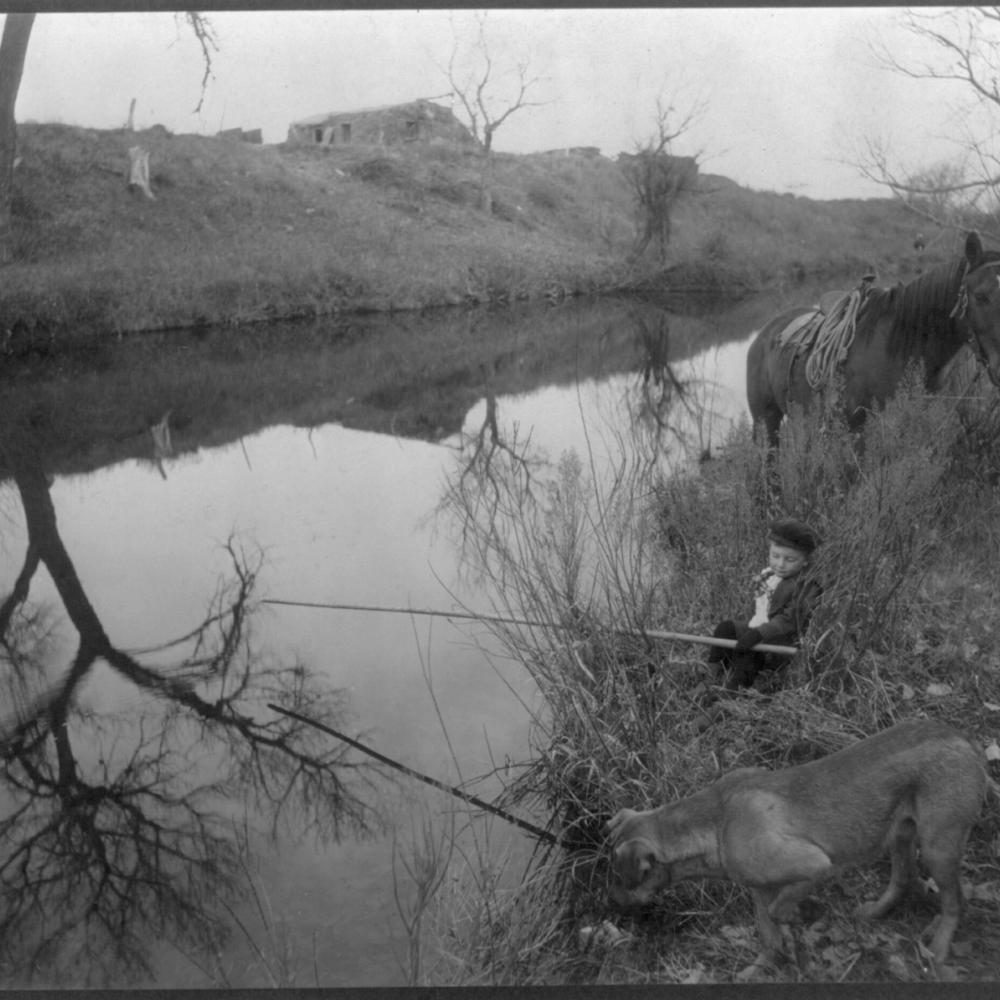Some of the images that have most influenced our idea of the old West were taken by a photographer who is almost completely unknown. Francis Marion Steele was a frontier photographer who traveled the Southwest Plains at the turn of the century, photographing the people who lived and worked there. His most famous shots are of cowboys on ranches in the late nineteenth century—roping cattle or sitting around a campfire after a day’s work. Others document railroad construction and the daily tasks that made up small-town life. His photographs help us understand what life was like for settlers on the western frontier.
Steele was born in 1866 in Stanton, Illinois. At thirteen, he began learning photography from G. T. Atkinson in Kansas City, Missouri. He moved west to Dodge City, Kansas, in 1890, and a year later began traveling through the Southwest Plains. He carried his studio with him: His wagon held a tent darkroom and about seventy pounds of equipment. He advertised himself as “The Tourist Photo Artist,” and went around taking photos of daily life, then trying to sell the prints to the subjects he had caught on film.
“Steele’s work with ranching, covering the heart of the Southwest Plains cattle country, is better known than his name, for over the years many of his photographs have been used, without attribution, as illustrations for books and articles on cowboys and the West,” says Jim Hoy, who gives presentations about Steele through the Speakers Bureau of the Kansas Humanities Council.
In the early years of the twentieth century, Steele began to operate from a series of studios he established in towns in southwest Kansas and western Oklahoma. He expanded beyond cowboys and ranching and started photographing all aspects of rural life in the Southwest Plains—agriculture, irrigation and railroad construction, and farmhouse portraits. “One aspect of his business,” writes Hoy, “was to advertise in a local paper that he would be in a certain area, available to take photographs . . . for a period ranging from a few days to a couple of weeks, then he would return to his studio to develop and finish the photographs.” He was often commissioned to shoot new homeowners standing proudly with their whole families in front of their new house. Ranchers hired him to photograph their cowboys at work.
After settling for ten years in McCook, Nebraska, with his wife and son, Steele returned to Dodge City in 1935. He had been hired by the city to set up a display of cowboy paraphernalia and historic photographs to encourage tourism. He also planned to present his stills and cowboy gear to children at local schools. In January 1936, however, before his plans could be carried out, he and his wife, Sadie, died. One morning, Steele rose to make coffee and then returned to the bedroom to check on his wife, forgetting about the coffee, which boiled over and extinguished the burner. Gas filled the apartment killing Steele and his wife.
In 2003, Jim Hoy and his wife, Catherine, began searching for photos taken by Steele. Until then, Hoy, who is the director of the Center for Great Plains Studies at Emporia State University, had encountered only the fifty-eight Steele photographs that made up the Berryman Collection, held by the Krier Pioneer Museum in Ashland and the Kansas State Historical Society in Topeka. Hoy and his wife have now located nearly five hundred prints. Based on period newspaper articles, however, Hoy estimates that Steele took almost a million photographs in his lifetime.
In an essay on Steele’s work, Tom Rankin, the director of the Center for Documentary Studies at Duke University, says that because of the commercial nature of Steele’s photography, there is no apparent slant to his work: “In no way does Steele seem the least bit critical; he’s not indicting a system or way of labor that he finds exploitative. . . . He’s basically an optimist, a celebrant, at least in his pictures.” Hoy agrees: “He was not a critic. He had no political or social agenda—he was just trying to show people’s lives. He wasn’t trying to glorify them, he was just trying to say, ‘this is what it is.’”
Hoy thinks that Steele did not see himself as a documentary photographer, yet his work serves as a chronicle of life in the West at the turn of the twentieth century. “Historians and sociologists, not to mention photography critics,” says, Hoy, “will find much to study and much to admire in photographs that show a changing West, that document the advance of the plow and the railroad as well as the herds of cattle.”


